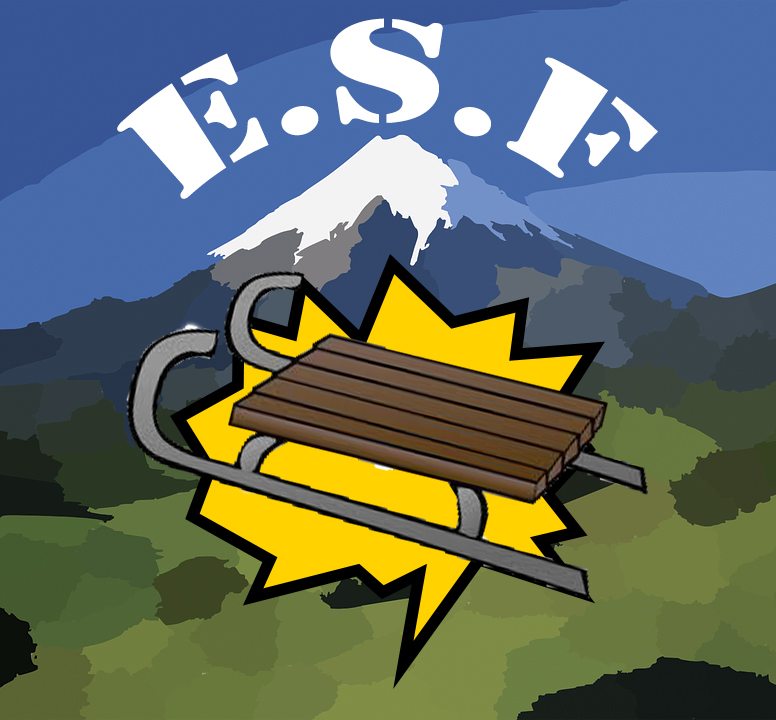The previous decade has served witness to a plethora of new and unusual pastimes emerging from the hearts of a listless population and the internet. With most recreational mediums having already been exhausted, outdoor adventure junkies have deferred to radical remixes of past traditions. These remixes have come to fruition in the form barefoot mountain climbing, unicycle fly-fishing, umbrella base jumping, competitive rock and bark chewing, and most notably, the controversial activity of extreme sledding.
Following the announcement of a large-scale extreme sledding extravaganza in Salt Lake City this November, the SledShred420 Tributary SledFest, what was once an isolated internet phenomenon has drawn fiery scrutiny from concerned Utah locals hoping to rescind the event altogether. At present, one question rests on the minds of local legislators and media representatives alike: What on earth is extreme sledding? And how did it come to be?
The singular traceable origin of this practice is a sequence of YouTube videos published between 2013 and 2014 by a bearded young man identifiable only by the screen name SledShred420. Over the course of that year, the YouTuber accumulated mass viewership as his videos grew progressively more outrageous; what began as tame sled and snowsuit reviews quickly transitioned into death-defying sled runs. The Colorado local took his collection of sleds — some circular, some railed, and in one instance simply a tarp under his knees — to some of the state’s most precarious slopes and plummets, including the Capitol Peak knife-edge ridge. SledShred420 became a spark, and subsequently a martyr, for the emergent sport when he tragically perished in New York City after sledding down the Statue of Liberty’s nose — his death a result of choking on a gourmet hot dog at a food cart in downtown Manhattan later that day.
With the help of online forums and social media, SledShred420’s supporters and extreme sledding activists coalesced to form the Extreme Sledding Federation (ESF). They are behind the SledShred420 Tributary SledFest.
On the event’s final day, festival attendees plan to link hands and perform an unprecedented ‘Flying W’ run, sledding down from the Millcreek ridge, up and over the Cottonwood Divide between Big and Little Cottonwood Canyons, and ultimately land (ideally) somewhere near Red Pine Lake, where they will have lunch and take a group photo.
At the moment of the festival’s announcement, fervent protests ensued, primarily from concerned parents and environmentalists — the latter claimed sledding on bare inclines damages natural foliage and ecosystems. Many of the demonstrators present were unfamiliar with the organization and were drawn out by the insatiable compulsion to protest something.
A startling detail not present on the ESF’s website is the fact that over 65 percent of its members are children. While the organization requires a permission slip for all minors aspiring to join its ranks, Utah mothers fear that even the presence in the city is harmful.
One exasperated mother at last week’s anti-ESF rally believes the organization puts her daughter at risk.
“Last week, Sally said that she wanted to go to sledding. I told her that we couldn’t go, since it hasn’t snowed yet,” the mother, Brittany Smith says. “Shortly after, she took her sled and flew right off the roof, destroying our garden and covering herself in scrapes and bruises. Sure enough, the first item on her search history was that darn extreme-o website. These maniacs must be stopped.”
Another parent I spoke to, however, was supportive of the ESF and its upcoming festival.
“Well, the kiddos have been raving about this fad for weeks now,” Jim Bumps says. “It’s a little dangerous, sure, but as long as it gets them outside and off the Xbox, I’m okay with it. So what if they get a little beat up? When I was their age, I used to chase rattlesnakes with a stick and wrestle the neighbor’s horse. I turned out okay.”
His children are currently practicing members, and they plan to train for the festival on Olympus’ northern face later this week.
At present, it is uncertain how long protests will continue, though it certainly appears that the festival is still on. A recent tweet from Powers advises that “[Utah locals] better wax their sleds or stay inside — it’s going down, and going down quick.”
The outcomes of this largescale event are anyone’s guess, but it is advised that you wear a helmet if you plan to participate and avoid hiking in the canyons that day if you do not.


